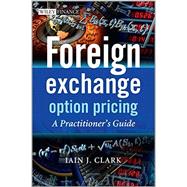
What is included with this book?
List of Tables.
List of Figures.
1 Introduction.
1.1 A Gentle Introduction to FX Markets.
1.2 Quotation Styles.
1.3 Risk Considerations.
1.4 Spot Settlement Rules.
1.5 Expiry and Delivery Rules.
1.6 Cutoff Times.
2 Mathematical Preliminaries.
2.1 The Black–Scholes Model.
2.2 Risk Neutrality.
2.3 Derivation of the Black–Scholes equation.
2.4 Integrating the SDE for ST.
2.5 Black–Scholes PDEs Expressed in Logspot.
2.6 Feynman–Kac and Risk-Neutral Expectation.
2.7 Risk Neutrality and the Presumption of Drift.
2.8 Valuation of European Options.
2.9 The Law of One Price.
2.10 The Black–Scholes Term Structure Model.
2.11 Breeden–Litzenberger Analysis.
2.12 European Digitals.
2.13 Settlement Adjustments.
2.14 Delayed Delivery Adjustments.
2.15 Pricing using Fourier Methods.
2.16 Leptokurtosis – More than Fat Tails.
3 Deltas and Market Conventions.
3.1 Quote Style Conversions.
3.2 The Law of Many Deltas.
3.3 FX Delta Conventions.
3.4 Market Volatility Surfaces.
3.5 At-the-Money.
3.6 Market Strangle.
3.7 Smile Strangle and Risk Reversal.
3.8 Visualisation of Strangles.
3.9 Smile Interpolation – Polynomial in Delta.
3.10 Smile Interpolation – SABR.
3.11 Concluding Remarks.
4 Volatility Surface Construction.
4.1 Volatility Backbone – Flat Forward Interpolation.
4.2 Volatility Surface Temporal Interpolation.
4.3 Volatility Surface Temporal Interpolation – Holidays and Weekends.
4.4 Volatility Surface Temporal Interpolation – Intraday Effects.
5 Local Volatility and Implied Volatility.
5.1 Introduction.
5.2 The Fokker–Planck Equation.
5.3 Dupire's Construction of Local Volatility.
5.4 Implied Volatility and Relationship to Local Volatility.
5.5 Local Volatility as Conditional Expectation.
5.6 Local Volatility for FX Markets.
5.7 Diffusion and PDE for Local Volatility.
5.8 The CEV Model.
6 Stochastic Volatility.
6.1 Introduction.
6.2 Uncertain Volatility.
6.3 Stochastic Volatility Models.
6.4 Uncorrelated Stochastic Volatility.
6.5 Stochastic Volatility Correlated with Spot.
6.6 The Fokker–Planck PDE Approach.
6.7 The Feynman–Kac PDE Approach.
6.8 Local Stochastic Volatility (LSV) Models.
7 Numerical Methods for Pricing and Calibration.
7.1 One-Dimensional Root Finding – Implied Volatility Calculation.
7.2 Nonlinear Least Squares Minimisation.
7.3 Monte Carlo Simulation.
7.4 Convection–Diffusion PDEs in Finance.
7.5 Numerical Methods for PDEs.
7.6 Explicit Finite Difference Scheme.
7.7 Explicit Finite Difference on Nonuniform Meshes.
7.8 Implicit Finite Difference Scheme.
7.9 The Crank–Nicolson Scheme.
7.10 Numerical Schemes for Multidimensional PDEs.
7.11 Practical Nonuniform Grid Generation Schemes.
7.12 Further Reading.
8 First Generation Exotics – Binary and Barrier Options.
8.1 The Reflection Principle.
8.2 European Barriers and Binaries.
8.3 Continuously Monitored Binaries and Barriers.
8.4 Double Barrier Products.
8.5 Sensitivity to Local and Stochastic Volatility.
8.6 Barrier Bending.
8.7 Value Monitoring.
9 Second Generation Exotics.
9.1 Chooser Options.
9.2 Range Accrual Options.
9.3 Forward Start Options.
9.4 Lookback Options.
9.5 Asian Options.
9.6 Target Redemption Notes.
9.7 Volatility and Variance Swaps.
10 Multicurrency Options.
10.1 Correlations, Triangulation and Absence of Arbitrage.
10.2 Exchange Options.
10.3 Quantos.
10.4 Best-ofs and Worst-ofs.
10.5 Basket Options.
10.6 Numerical Methods.
10.7 A Note on Multicurrency Greeks.
10.8 Quantoing Untradeable Factors.
10.9 Further Reading.
11 Longdated FX.
11.1 Currency Swaps.
11.2 Basis Risk.
11.3 Forward Measure.
11.4 LIBOR in Arrears.
11.5 Typical Longdated FX Products.
11.6 The Three-Factor Model.
11.7 Interest Rate Calibration of the Three-Factor Model.
11.8 Spot FX Calibration of the Three-Factor Model.
11.9 Conclusion.
References.
Further Reading.
Index.
The New copy of this book will include any supplemental materials advertised. Please check the title of the book to determine if it should include any access cards, study guides, lab manuals, CDs, etc.
The Used, Rental and eBook copies of this book are not guaranteed to include any supplemental materials. Typically, only the book itself is included. This is true even if the title states it includes any access cards, study guides, lab manuals, CDs, etc.